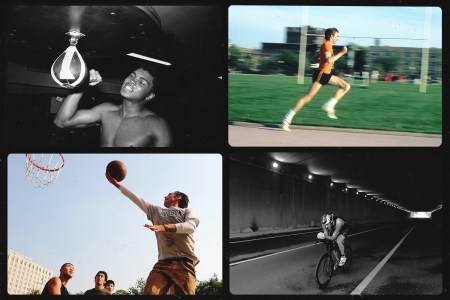I broke one of my own rules the other night, scrolling social media for who-knows-how-long before bed. As a self-congratulatory wellness columnist, I tend to discourage the habit.
It was the usual crap, until I landed on a clip of a former Rutgers nose tackle, from The Bronx, who’d stopped to chat with one of those now-ubiquitous sidewalk interviewers along West Drive in Central Park. The premise of the “show” was asking fit strangers how they stayed in shape, and the man certainly fit the bill. He was tall, sculpted, wearing a weighted vest and nearly done with a three-mile run. But it was his backstory, which unraveled in less than a minute, that made him all the more memorable and sympathetic. He explained that he’d spent his 20s battling schizophrenia, a development he attributed to concussions. He extolled the healing forces of exercise, saying it sometimes felt more effective than his medication.
With the right algorithm, you can hunt down similar, bite-sized samples of real-life inspiration like this all over the internet: on Instagram, on YouTube, in podcasts, wherever. They’re a nice boost, a healthy dose of perspective, a reminder that we’re meant to move.
That exact video stuck with me, though. It flipped a switch, got me thinking about a different medium entirely. Perhaps it was because the man’s story — his unfair plight and brave demeanor — felt practically novelistic. Or perhaps it was because I was lying in bed, at a time of the day usually reserved for reading. I drifted to sleep thinking about stories and characters and the worlds they inhabit and move through. All the necessary action that unfurls as they try (willingly or wittingly or neither) to chase answers, process trauma and find love.
How to Pair Your Daily Exercise With Your Mood
From happy to hungover: 10 moods and the workouts that work bestReading for Empathy
We’re accustomed to associating reading with self-improvement, to view books as a general good, capable of stage-lighting the human condition. Analysis published in 2013, brought forth by the New School for Social Research, found that reading literary fiction improves one’s “theory of mind.”
It’s a psychological concept with close ties to our understanding of empathy; the theory of mind refers to one’s ability/tendency to understand that other people are different, to give them credit for their unique mental states. (You have different wants, dreams, desires, influences and intentions than I do.) The researchers found that when subjects read classics by Chekhov or Dickens, or celebrated modern texts by Téa Obreht or Don DeLillo, they had a tangible “social experience.” Their empathy calvary came charging in.
Stories challenge us with places or situations that we haven’t considered (that we otherwise might have never imagined) and say: “Look at that. How strange.” Or “how sad,” “how amazing,” etc. We watch characters make decisions, we wonder how we might have reacted in their stead. Something happens in our brains as we read, sitting there on a chair, a train, the beach.
Book, Brain and Body
At the same time, studies have confirmed that a sort of transformation manifests in our physical bodies.
In 2016, the Yale School of Public Medicine declared that reading just one chapter of a book a day could increase longevity: “People who read books for at least 30 minutes a day live nearly two years longer than non-readers.” And research from the University of Sussex related reading with a decreased heart rate, concluding it can relieve stress by 68%.
In such a harried age, this makes a whole lot of sense; books aren’t just a cerebral CTA, they’re also a distinct clamp on whatever stressors are chewing up your month. Dipping into other worlds relaxes us. It gives us time to ourselves that isn’t time spent on social media. (Most social media videos don’t inspire an entire essay!) It helps us sleep.
Fiction as Fitness Inspiration
But could books also help us move? The more I’ve thought about it, the more I’m sure: fiction is an unlikely yet reliable platform for fitness inspiration. The simple physical traditions of the characters we get to know well can serve as a potential blueprint for more exercise (or at least, exploration) in our own lives.
There are instances in literature where characters actually have dedicated training regimens — a sort of funny one I always remember is Robert Langdon, of Angels and Demons and Da Vinci Code fame, who swims 50 laps every morning at a Harvard field house. (This evidently affords him the necessary cardiovascular fitness to stay one step ahead of Interpol.) Strength training or skillset-oriented regimens are common in paperbacks about spies, survivalists or sportspersons.
When, though, does a character’s specific physical activity — fencing, playing basketball, taking the boat out to sea — elevate from a verb on the page to something we can claim? When does it compel us to move, too? I think this happens when the exercise isn’t an extraneous detail, shoved in by the author, but a self-prescribed form of therapy, chosen and abided by the character.
Think about how often characters find themselves out on a ramble: Leopold Bloom, Elizabeth Bennet, Toru Watanabe. The most prolific exercise in the history of literature is walking. You can see why authors favor it — keeping characters on the couch all day isn’t any fun. And you can see why characters repeat it, whether they want to or not — walking represents salvation, escape, discovery, perspective. Maybe even medication.
When characters go on walks (or quests, the greatest “walk” of all), we get a chance to see their world. We too walk around Gogol’s Saint Petersburg, Döblin’s Berlin, Paulsen’s Great White North. The trip can be unsavory or underwhelming, but it’s still a trip; it’s a reminder that when you leave your house, things happen. When you move, you take things in, make connections and recognize changes in yourself. You begin something.
“We Are Dancing Animals”
Kurt Vonnegut was a writer, not a fitness influencer. But he also once said this: “We’re dancing animals. How beautiful it is to get up and go do something.”
We live in the most sedentary moment in human history. We know for a fact that the baseline needs to be more movement, that exercise improves physical and mental wellness (just as the man in the Central Park video hypothesized). This means all wellsprings of potential fitness inspiration should be on the table. Even the unlikely ones, that don’t arrive via an app or a screen.
If you’re looking to jumpstart a routine — a physical rhythm of any stripe — read a story. Watch what the character gets up to, how intangible movement is to the ebb and flow of their days. Let your empathy morph to intrigue, even envy. If they get to move, so should you. Who the hell knows? This approach may inspire you to grow a garden, or start racing cars. At the very least, it will get you out of your chair.
The Charge will help you move better, think clearer and stay in the game longer. Subscribe to our wellness newsletter today.


























